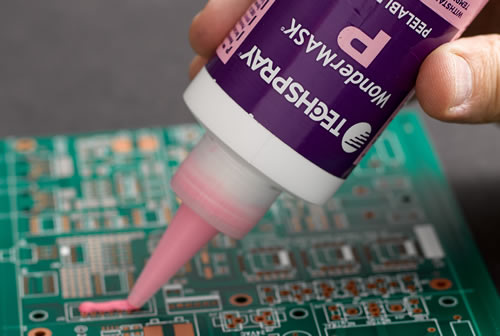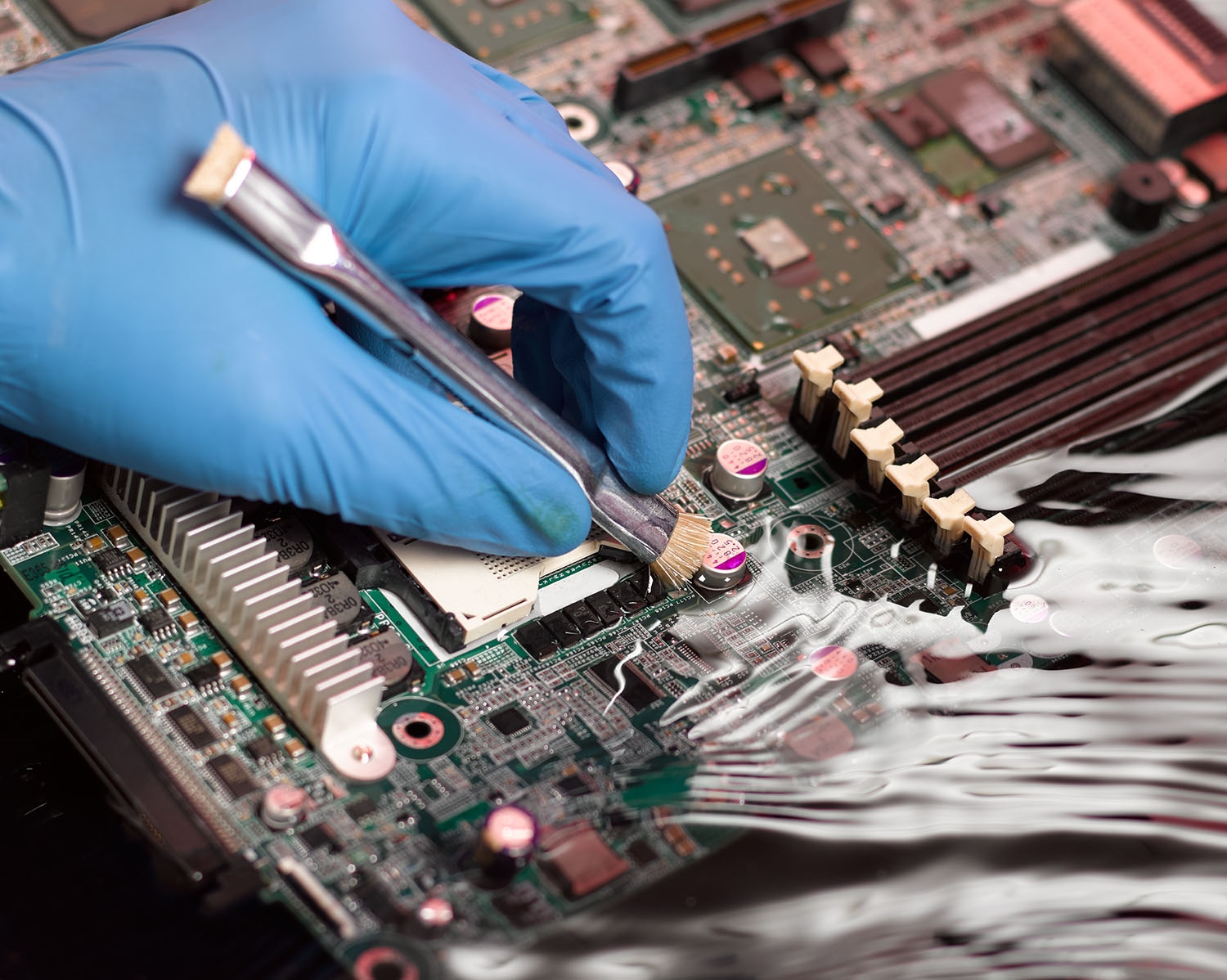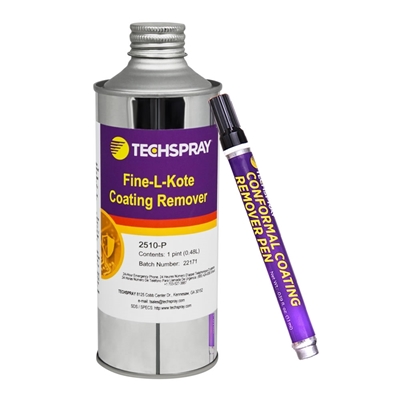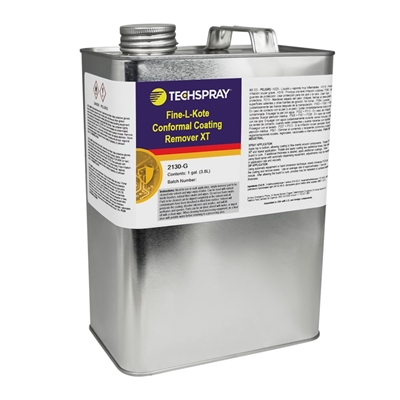This procedure covers the methods to identify the conformal coating so that the ideal removal method can be identified and utilized, then presents a commonly-employed removal procedure with brief summaries of the other removal methods.[1]
Click here to see a video demonstration on removing conformal coating.
What are the Different Types of Conformal Coating?
IPC-CC-830 has superseded MIL-46058 as the primary specification for conformal coatings on printed circuit assemblies. This covers the following conformal coating types:
- Type AR – Acrylic Resin
- Type SR-- Silicone Resin
- Type UR—Polyurethane resin
- Type ER—Epoxy Resin
- Type XY—Parylene
These coatings can be grouped into two categories—those able to be removed by chemical solvents and those which cannot:
- Can be removed by solvent - conformal coatings made of acrylic are ideally suited for chemical removal. Silicone and polyurethane are also suitable materials, but may require manual agitation.
- Cannot be removed by solvents - Those coatings made of Epoxy and Parylene require physical (scraping, abrasion) rather than solvent removal methods.
How to Identify the Type of Conformal Coating?
In order to identify the appropriate coating removal procedure you must first identify the coating employed. During manufacture, this is known and can be specified. Labels may be present on the assembly, which should conform to Standards such as IPC-1066 (superseded by IPC/JEDEC J-STD-609) and IPC/JEDEC J-STD-609.
These labels are not always available or visible, but with simple observation and testing you can identify the coating characteristics sufficient to select the proper removal procedure. The generic or commercial identification is not necessary.
The following approaches will assist your identification:
- Hardness: Perform a penetration test in a non-critical area. If it is medium hard or soft, it is suitable for chemical solvent. If it is hard, it is not.
- Transparency: Transparent coatings are usually more suitable for removal than opaque coatings. Removal methods used with opaque coatings must be far more controlled to prevent damaging covered component and board elements.
- Solubility: In a small noncritical area, brush isopropyl alcohol and observe. Do not immerse printed board assemblies in harsh solvents in testing; some solvents can damage components.
- Visual Inspection: Inspect or use small tools to determine if the surface is glossy or dull, if it adheres strongly to the board, and\or is susceptible to chips, peeling or flaking, scratches or tears, or if it stretches.
Other tests can be performed for alternative removal methods, including thermal removal and stripability. Many of these tests in isolation do not identify whether chemical solvent is a suitable removal method, but may assist if you need to know the specific coating for other purposes. Refer to the IPC 7711/7721.2.3.1 standards.
The following is a summary of how to identify specific coating types: [1]
- Acrylic Resin (AR) – Glossy surface, reacts to heat, strong bond, and readily dissolves with common solvents. glossy surface.
- Silicone Resin (SR) – Semi-gloss rubbery surface, and soft so easily scraped off.
- Polyurethane resin (UR) – Glossy hard surface that is more solvent resistant than AR.
- Epoxy Resin (ER) – Glossy hard surface that is solvent resistant.
- Parylene (XT) – Matte hard surface that is solvent resistant. Because it is applied by vapor deposition, it will be much more even over all surfaces and component corners.
What is the Best Way to Remove Conformal Coating?
Once you have identified your conformal coating material, you can best assess which removal method to utilize. Many commonly used conformal coatings require chemical solvents either in isolation or in tandem with another removal method. As an industry leader for 60 years, Techspray offers expertise as well as two leading products for these applications: Fine-L Kote Coating Remover and Fine-L-Kote Coating Remover XT.
The following are all the removal methods covered in this paper with the relevant coatings for each [1]:
- Chemical Solvent (based on IPC 7711/7721.2.3.2, Coating Removal, Solvent) – Best for AR, SR and UR coatings.
- Peeling (based on IPC 7711/7721.2.3.3, Coating Removal, Peeling) – Best for thick SR.
- Thermal (based on IPC 7711/7721.2.3.4, Coating Removal, Thermal) – Good for all coatings except thick SR.
- Grinding\Scraping (based on IPC 7711/7721.2.3.5, Coating Removal, Grinding\Scraping) – Best for XY, EP, UR, and thick SR.
- Micro Blasting 9based on IPC 7711/7721.2.3.6, Coating Removal, Micro Blasting) – Best for XY and EP.
Removal by Chemical Solvent [2]
Many commonly employed conformal coatings are ideally suited for chemical removal, either in isolation or in tandem with another method. Acrylic is ideally suited for solvent removal, while silicone, polyurethane and one-part epoxy benefit from chemical removal in combination. Two-part epoxy and parylene are not suitable for chemical removal.
The following are important details that will ensure a safe and efficient cleaning process:
- Solvent choice – Conformal coating resins generally require relatively harsh solvents to dissolve them. Aromatic solvents like toluene and xylene are commonly used. Acetone or hydrocarbons like hexane might also be used depending on the coating. Consult with your coating manufacturer for the best match. Techspray offers Conformal Coating Remover and Conformal Coating Remover XT, which are specifically formulated to cut the widest variety of coatings including acrylic, silicone, and urethane. Isopropyl alcohol (IPA), which is commonly found around most PCB repair areas is usually not strong enough to break down conformal coating.
- Container - To remove conformal coating from the entire circuit board, you will need to find a container large enough for the board to fit and soak in the solvent. Look for something made of stainless steel, and avoid aluminum and certainly plastics, which can be affected by the harsh solvents.
- Ventilation -You will also need very good ventilation to remove the fumes from your work area. Many of the solvents can cause health issues if exposure is too high over a prolonged period. It’s imperative in flammable solvents to evacuate the fumes. An explosion-proof ventilation hood is an ideal choice.
- PPE (Personal Protection Equipment) - Personal protection equipment is also important to keep the solvents off your skin and out of your body. Use gloves made of a solvent-resistant material, like nitrile, and safety glasses or goggles. Consider a face shield if you plan to do a lot of scrubbing, which will also keep solvent out of your mouth and nose. Additional safety equipment and garments might be needed depending on the expected exposure level.
- UV “black light” inspection lamp – Most conformal coatings contain a UV tracer or brightener, so the coating glows under the ultraviolet (UV) spectrum of light. Ideally, other lights are blocked so only coated areas glow, and everything else is dark. The UV lamp should have a wavelength between 320-380 nm.
Coating Removal for Isolated Areas
If all you are doing is replacing a component, or working on an isolated area, there are coating removers available in pen packaging, or you can use a conformal coating remover solvent with a swab, wipe, or brush. The following contains more information on the types of materials needed:
- Conform Coating Remover Pen (part #2510-N) – Specialized solvent intended for removing conformal coating is available in a pen dispenser. You press the pen tip, which releases the solvent and saturates the tip. For tough coating, you can hold down or pump the tip valve to over-saturate the area and let it soak. Chemtronics also offers CircuitWorks Conformal Coating Remover Pen.
- Brushes – Dry brushes help break down the coating or separate it from the board surface. A stiff natural bristle is recommended because it can absorb solvent, and does not risk scratching the board or component surfaces. Horse hair or hog hair brushes are ideal, and closely trimmed so they are stiff. Have several brush size or tip types ready to make it easier to cover large surfaces or to reach tight areas or for aggressive scrubbing needs either with or without solvent. Techspray offers technical brushes that are even trimmed to a point to get into tight areas. Nylon bristle brushes (e.g. tooth brushes) can have a tendency to generate static, so should be avoided.
- Polyester Knit Swabs – Polyester knit fabric wrapped swabs are ideal because they are tough enough to withstand the harsh solvents and aggressive scrubbing action. Foam swabs will tend to swell and break down when exposed to the types of solvents used for coating removal. Cotton bud swabs (e.g. Q-tips) have a tendency to fray and leave behind particulates or FOD (foreign object debris), a type of defect that could get a reworked PCBA rejected.
- Polyester Knit Wipes – Similar to swabs, a polyester knit fabric is ideal for wiping off dissolved coating. Cellulose (e.g. Kimwipes) or poly-cellulose wipes tends to fray when brushing over leads or sticking to partially dissolved tacky coating.
Step 1 - Mask
Mask any sensitive areas of the board or outline the area to be removed with polylmide tape or another suitable mask such as Wondermask temporary solder masks. Solder mask provides the option to cover around irregular areas and over uneven surfaces.

Step 2 - Prep Instrument containing the solvent
Depending on the size and orientation of the coating to be removed, prepare your tool with the solvent.
If using a pen, saturate the pen tip by pressing it down on a hard surface several times, which quickly opens and closes the valve allowing solvent to flow through the tip material.
Dip swabs or brushes into a clean vial of solvent, depending on how stubborn or extensive the coating is, you may need several on hand.

Step 3 - Scrub and apply
Simply scrub the surface you intend to strip with your solvent-soaked tool.
You may have to allow the solvent to flow and sit on the board’s surface to give the solvent a chance to break down the coating.

Step 4 - Maintenance
Note that coating resin can build up, so you will need to rub off the buildup onto wipe material and resaturate the tip or select a new brush, swab, or portion of wipe before continuing.

Coating Removal from Entire PCBA
In some cases, a more substantial part of the board needs to have the coating removed. In these cases, it’s much easier to remove the coating from the entire assembly or masking only discrete areas and immersing the assembly to remove the remainder.
Step 1 - Masking.
If some portions of the board need to be protected from the solvent, mask them with polylmide tape or another suitable mask such as Wondermask temporary solder masks.

Step 2 - Soak
Completely soak the board in the solvent for at least an hour. The type of coating and its thickness may mandate additional soaking time or scrubbing.
Acrylic tends to be the easiest and often fully dissolves, or only requires a minor amount of scrubbing. The coating will remain clear as it dissolves, but will still be visible as the solvent flows over the board.

Step 3 - Scrub and Rinse
Lift the board, and rinse with fresh solvent. Scrub if needed, and allow the solvent to flow over the board. Don’t put the board back into the contaminated solvent, use a second container if further soaking is needed.
Silicone and urethane may require a long soak time and greater agitation. The solvent may only separate the coating from the surface of the board, but you can use the brush to help the separation.


Step 4 - Repeat, Scrub and Rinse
Again, rinse with fresh solvent, and repeat as necessary.
Step 5 - Dry and Inspect
Allow the board to fully dry before plugging it back in. After it is dry, you can check your work under a UV “black light” inspection lamp to ensure both the coating has been removed as needed, and that no unintended damage has occurred.
If you see any glowing areas, repeat the rinsing process.

Coating Removal, Peeling [3]
Peeling is a suitable removal method if the conformal coating is thick enough, but only if the coating is made of silicone. The risks with this approach include damage to the sensitive components and leads. Chemical solvent may be a helpful initial step to loosen the bond.
Coating Removal, Thermal [4]
Thermal tools can be suitable in part for many conformal coatings, including parylene, Epoxy, Acrylic, Polyurethane and thin silicone. However, for many of these, thermal removal is not sufficient on its own and may require solvent or abrasion. In addition, it can cause issues with sensitive components and adds unnecessary thermal stress to the board substrate.
Coating Removal, Grinding\Scraping[5]
Grinding or scraping conformal coating can be performed on all coating types but it can’t be done in isolation. It will almost certainly require a step prior to loosen the coating. Polyurethane and thin silicone in particular will benefit from a combined solvent-and-scrape approach.
Coating Removal, MicroBlasting [6]
Instead of grinding or scraping, microblast (using a tool to direct intense agitation to) parts of the conformal coating that needs to be removed. Like grinding, it can be employed on all types of conformal coating, however in nearly all cases, it wouldn’t be an effective method in isolation. Either solvent or thermal aids would be needed as well.
Exceptions and Considerations
All printed circuit boards need to be assessed on a per case basis. Just as the coating needs to be assessed to determine which removal is best, the overall board type, sensitivity, and components need to be assessed. Critical elements require a more robust quality control and manufacturing new boards may be safer for the final installation than risk injuring a sensitive component. However, for most use cases involving acrylic, silicone, and urethane the use of chemical solvents is the best universal method to remove coatings as they prevent the stress on the board from thermal or abrasive methods.
Contact us for the best advice for your immediate needs. With over 40 of experience in conformal coating, we’re ideally suited to advise you on the best product and approaches for your particular application. Techspray’s TechLab has state-of-the-art cleaning, coating and analytical equipment to help customers optimize their processes.
For more information on conformal coatings, check out our Essential Guide to Conformal Coating [7] or contact a technical specialist at 800-858-4043 or tsales@techspray.com.
References
[1] IPC 7711/7721.2.3.1, Rework, Modification, and Repair of Electronic Assemblies: Coating Removal, Identification of Conformal Coating
[2] IPC 7711/7721.2.3.2, Coating Removal, Solvent
[3] IPC 7711/7721.2.3.3, Coating Removal, Peeling
[4] IPC 7711/7721.2.3.4, Coating Removal, Thermal
[5] IPC 7711/7721.2.3.5, Coating Removal, Grinding\Scraping
[6] IPC 7711/7721.2.3.6, Coating Removal, Microblasting
[7] “Essential Guide to Conformal Coating”, https://www.techspray.com/the-essential-guide-to-conformal-coating









